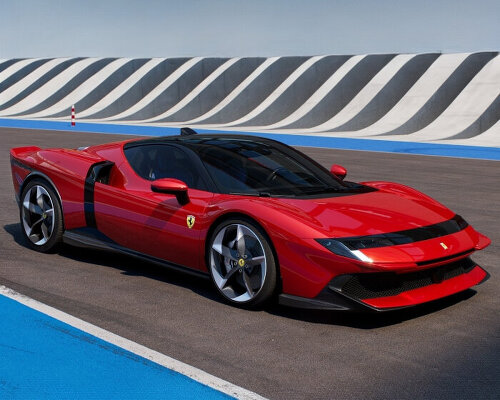Ferrari brings back testarossa car with 849
Ferrari unveils the 849 Testarossa, a revival of the company’s 1984 car, now a hybrid plug-in super sports berlinetta. Replacing the SF90 Stradale model, the sports car derives its name from Maranello’s history, Testa Rossa, which was first used on the 500 TR in 1956 to describe the color of the cam covers of some of Ferrari’s high-performance vehicles before being given its own proper car with the 1984 Testarossa.
Today, the once wedge-shaped vehicle gets a modern makeover, all the while keeping the familiar silhouette and look of its elder sibling. The Ferrari Styling Center, led by Flavio Manzoni, has worked on the design of the Ferrari 849 Testarossa car, starting with the lines that run vertically and horizontally across surfaces. They form geometric patterns, with the sharp edges separating different surface areas while the smooth curves connect the sharp edges.
all images courtesy of Ferrari
Tails that replicate the 512 S race car’s design
Starting at the front of the Ferrari 849 Testarossa car, the front bumper connects the headlights of the vehicle and creates a bridge shape. There’s a black splitter that sits below the bumper, and here, the body-colored flicks are also extended. Two tail sections appear at the rear, a means to replicate the 512 S race car’s design. An active wing moves between the tails, which can change its position in a second, and the center houses the three round exhausts. Ferrari forms the aluminum panels around the 849 Testarossa car separately, having machines cut them to exact shapes and workers weld them to the chassis frame.
It is this aluminum that the team uses for the door, designed with 3D curves and doubling as an air duct to allow the air to flow from it to the intercooler. It also has a main crease line, which runs from front to back, and black intake vents sit in the door side. Even the wheels are made from aluminum with diamond-cut surfaces covering the wheel faces and air channels running through the wheel spokes. The windshield visibly curves around the cabin, and the side windows fit flush with door surfaces. As for the rear window, it is integrated with the tail sections.
Ferrari unveils the 849 Testarossa, a revival of the company’s 1984 car, now a hybrid plug-in super sports berlinetta
racing car seats for 849 testarossa by ferrari
Inside the Ferrari 849 Testarossa car, the dashboard has two parts, with the upper one floating above the lower part. A band connects them, and it also holds the controls and screens. In the upper dashboard, the C-shaped vents sit, enclosed by aluminum frames. These vents direct the air into the cabin. Two sail shapes hold the controls in the lower dashboard, one for the passenger side and the other for the driver. Then, there’s a tunnel that runs between the seats, holding the secondary functions and using less space than before. Each door has one sail shape, which anchors one speaker covered with an aluminum grille.
Ferrari makes two seat types for the 849 Testarossa car: the comfort seats use fabric or leather, while the racing seats use carbon fiber backs with side bolsters. Since the door panels use less width at the bottom, they create more legroom, resulting in the rear seats having more space, too. On the dashboard, the driver and the front passenger have their own screens, both of which show the vehicle’s driving info. There’s another variant of the Ferrari 849 Testarossa car, and it goes by the name and style of the Assetto Fiorano.
lines run vertically and horizontally across surfaces and exterior of the vehicle
Assetto fiorano option with iconic stripes on the exterior
The Assetto Fiorano is an optional trim level of the 849 Testarossa, which has components that are not present in the red-colored vehicle. The model sheds 30 kilos from the original variant’s weight because it uses composite materials like carbon fiber and titanium, which are significantly lighter than the ones used in the primary car. Inside, the lightweight tubular seats upholstered in black Alcantara, which shaves 18 kilos of weight from the standard seats, are some of the specific components for the Assetto Fiorano, as well as the 20-inch carbon-fiber wheels that reduce mass and improve responsiveness when accelerating and braking.
The front of this model has larger flicks too, and its underfloor comes with an additional pair of vortex generators, which increase the airflow for aerodynamics. At the back, there are no longer twin tails, unlike in the Ferrari 849 Testarossa car, but two twin wings set between two vertical endplates. They help triple the vertical downforce without significantly affecting the aerodynamic drag. The Assetto Fiorano option can be completed with a livery in Bianco Cervino or Rossa Corsa, a reinterpretation of the classic double longitudinal stripes that start at the end of the bonnet, cross the roof, and then end on the rear deck.
two tail sections appear at the rear, a means to replicate the 512 S race car’s design
an active wing moves between the tails, which can change its position in a second
Ferrari forms the aluminum panels around the 849 Testarossa car separately
rear view of the vehicle
glimpse inside the vehicle
there are two options for the seats, with the racing kind having carbon fiber backs
the dashboard has two parts, with the upper one floating above the lower part
project info:
name: 849 Testarossa
car manufacturer: Ferrari | @ferrari
The post ferrari revives wedge-shaped car testarossa with the hybrid super sports berlinetta 849 appeared first on designboom | architecture & design magazine.

